Before embarking on your own meat goat raising journey, there are several factors to consider, one of those being what meat goat breed to choose. This blog post will cover the best breeds of goats for meat as well as their various attributes, both positive and negative, so you can make the right decision for your future herd and farm.
Table of contents
About Meat Goats
Let’s cover a little more information about meat goats before getting into the specific breeds. So what are meat goats? Meat goats are a type of goat that has been bred for the purpose of meat production. Overall, genetically meat goat breeds will be more muscular and have more body depth compared to other breeds, such as dairy goats.
Meat goats in the U.S. began to rise in popularity in the mid-90s when the USDA changed its rules for live sheep and goats imported from South Africa. This brought on an influx of Boer goats into the U.S.
While many meat goats are raised for meat production, this type of goat has become very popular as show goats, 4-H and FFA goat projects, and even backyard herds.
Meat goats, due to their size, are easier to handle and also keep on smaller acreage as compared to cattle, which make them a popular choice for many small farms or homesteads.
Top goat meat breeds covered
While there are many meat goat breeds, the specific breeds this post will cover include:
- Boer goat
- Spanish goat
- Savanna goat
- Myotonic goat
- Kiko Goat
Several other meat goat breeds not covered in this article include the Texmaster goat, Tennessee goat, Kalahari Red, and Pygmy goats.

Boer Goat
Originating from South Africa, the Boer goat is often considered to be the most common or quintessential meat goat – and considering their large frames and heavily muscled bodies, it’s easy to see why. The breed tends to be more docile and easy to handle.
Origin of the Boer goat
The Boer goats originated from South Africa. This breed of meat goats became very popular in the U.S. beginning in the 1990s when the U.S. lifted its restrictions on live imports of goats and sheep from South Africa.
Boer goat characteristics
Common Boer goat characteristics include a muscular, thick body frame with long ears that hang down around the face. Their horns grow back along their heads, rather than sticking out like the Kiko breed.
Boer goat colors
Traditional Boer goats have a white body with a red head. If you’re new to Boer goats, the term red may be a bit deceiving as the color is more of a brown with hints of red.
There are several other color variations for the Boer breed. These include:
Red Boer goat
A red Boer goat is usually all red in color. The red is a brownish red. Sometimes red Boer goats can be belted, which means they have a white colored band around the belly, or a partial band of white hair under the belly.
Black Boer goats
Black Boer goats are often very similar in coloring to the traditional white body and red head Boers. However, the black Boer goats have black colored heads instead of red. Sometimes this type of Boer goat can be all black as well,
Dappled Boer goats
Dappled Boer goats get a lot of attention by breed enthusiasts who like a variation of color and patterns. Dapple goats have the same body composition as a traditional Boer goat, but are typically a solid color, such as brown or black, with white spots. The white spots are what gives it the “dapple” name. Sometimes this pattern is also known as moonspots or even referred to as a spotted Boer goat.
Boer goat lifespan
The Boer goat lifespan can range from 10-12 years, if not longer. However, 6-7 years of age is a common range for productivity from a meat production standpoint.
Boer goat disadvantages
While Boer goats are one of the most popular breeds of meat goats, they do have a few disadvantages. Over time many genetic lines of the breed have favored the breed’s strength, which is its thick, muscular frame. As a result, less emphasis was placed on heartiness and parasite resistance.
It can be a challenge to raise some Boer goats on pasture or even forage (pasture or hay alone) due to the breeding selection and focus over the last 30 years.
Learn more about Boer goats
Learn more about the Boer goat breed in our in-depth article here, and with the American Boer Goat Association.
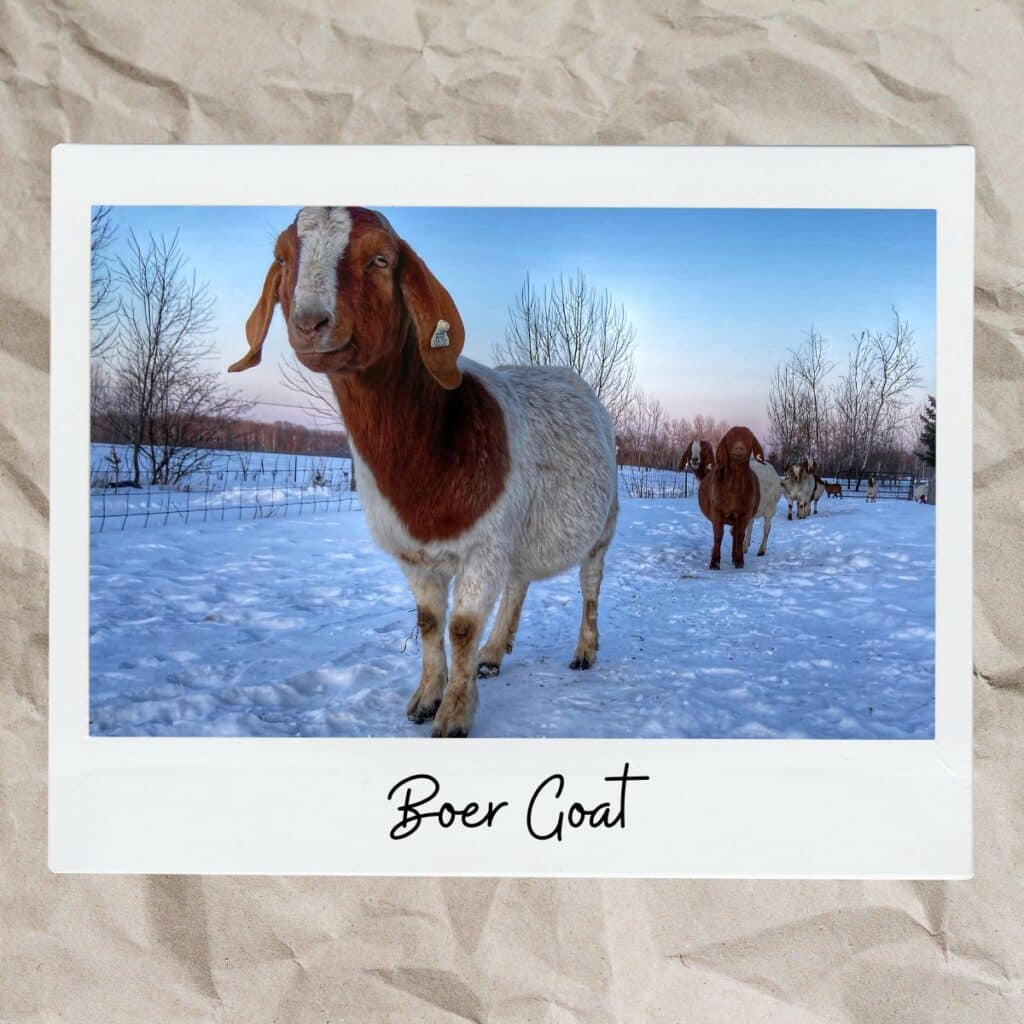
Spanish Goat
Descended from goats brought over by Spanish explorers, the Spanish goat (sometimes called a wood goat or hill goat), is another meat goat breed.
Characteristics of the Spanish goat
Spanish meat goats are extremely hardy and have great mothering instincts, though they’re less muscled and can be more difficult to handle. They have medium sized ears, but are smaller than the ears of the Boer goat, which stick out to the side. Spanish goats are also known for their long, spiraling horns.
Spanish goat colors
While the Spanish meat goat has a range of color variations, a common coloring is dark brown with shades of black, or light brown with shades of white.
Learn more about Spanish goats
Learn more about the Spanish goat in our in-depth breed article, as well as Spanish goat breed standards and registration information through the:
Spanish goats are more commonly found in the southern states of the U.S.
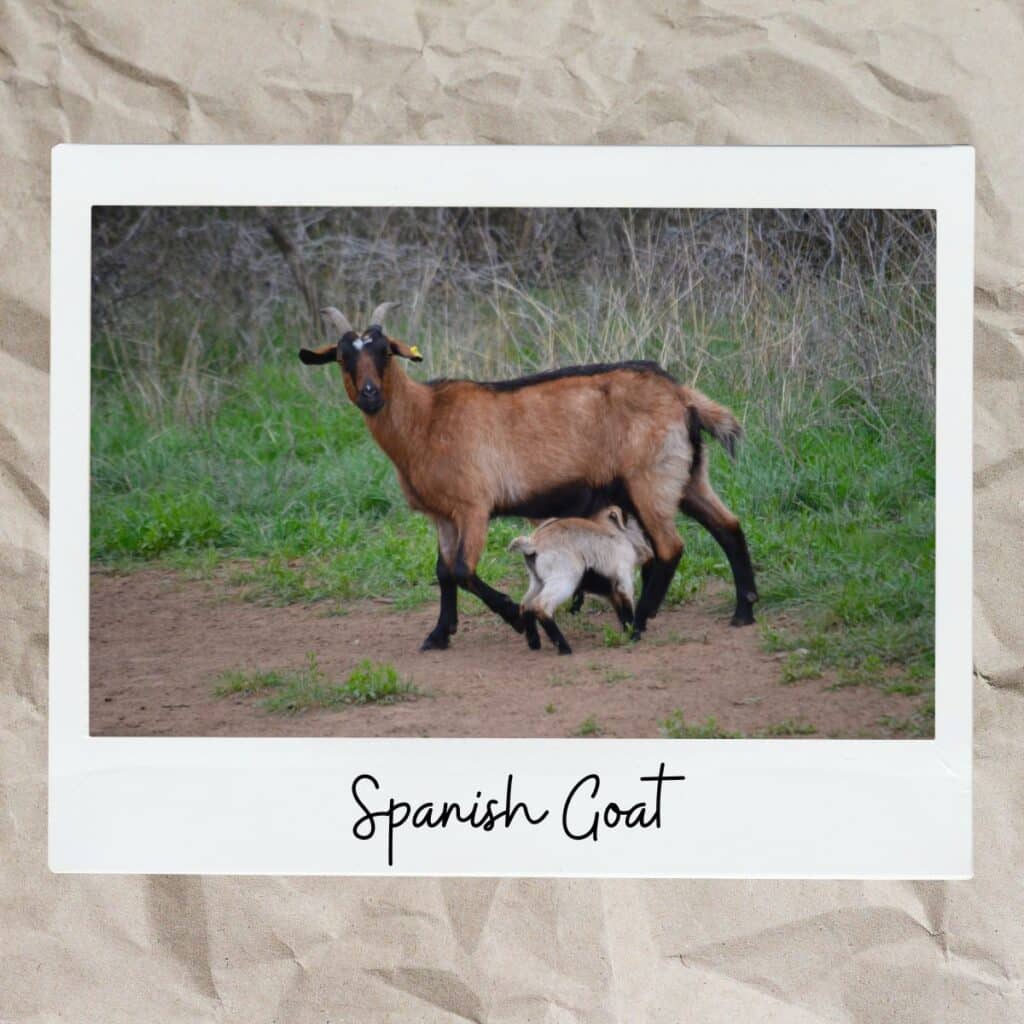
Spanish Goat Photo Credit: Thank you to Bear Family Farms of Texas for permission to use this photo. You can learn more about the farm on their YouTube channel.
Savanna Goat
The Savanna goat also originates from South Africa. While the breed of meat goats are growing in popularity in the U.S., the Savanna goat breed is still relatively uncommon compared to other meat goat breeds and therefore have a limited genetic base.
Savanna goat characteristics
The Savanna goat is built large like its Boer goat cousin though they’re objectively more hardy and disease and parasite resistant because of the environment in which they were raised – the savanna. They have long floppy ears and thick, muscular body frame.
Savanna goat colors
The Savanna breed is nearly all pure white in color but have distinct black skin, noses, horns and hooves.
Learn more about the Savanna goat in our in-depth article.
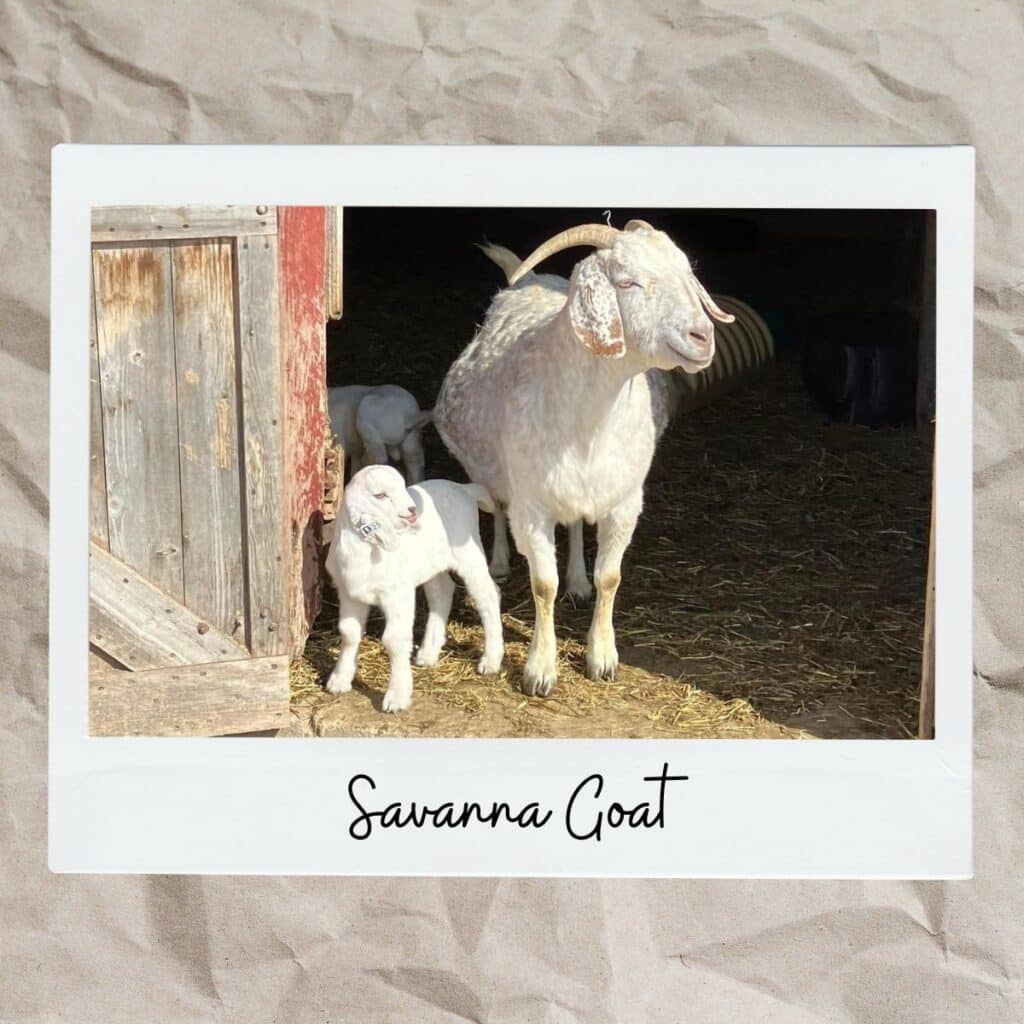
Savanna Goat Photo Credit: Thank you to Blue Stone Goats of Poynette, Wis., for permission to use this photo. You can learn more about their farm here.
Myotonic Goat
The Myotonic goat breed is native to North America and sometimes called the fainting goat, which is the breed’s most famous trait. The breed has many other names, such as Wooden-leg Goats, Tennessee Fainting Goats, nervous goats or scare goats.
Myotonic characteristics
When startled the goats will appear to fall over and faint with their muscles locking up in an episode of what’s called myotonia. This is why this breed has been nicknamed as the fainting goat. Because of this, the Myotonic goat certainly cannot be called a predator resistant breed of meat goat.
Myotonic goats tend to be docile in temperament, have good mothering traits, thrive in low-input forage management systems, and have better parasite resistance compared to other breeds. The breed varies in size and can have both short and long haired, shaggy coats.
While myotonic goats tend to be slower to mature, they are still known for their stocky, heavily muscled body frame.
Myotonic goat colors
The Myotonic breed comes in a wide variety of colors, ranging from white, brown to black, with varying patterns.
Learn more about Myotonic fainting goats
Learn more about this breed in our in-depth Myotonic / Fainting Goat breed article and with these organizations:
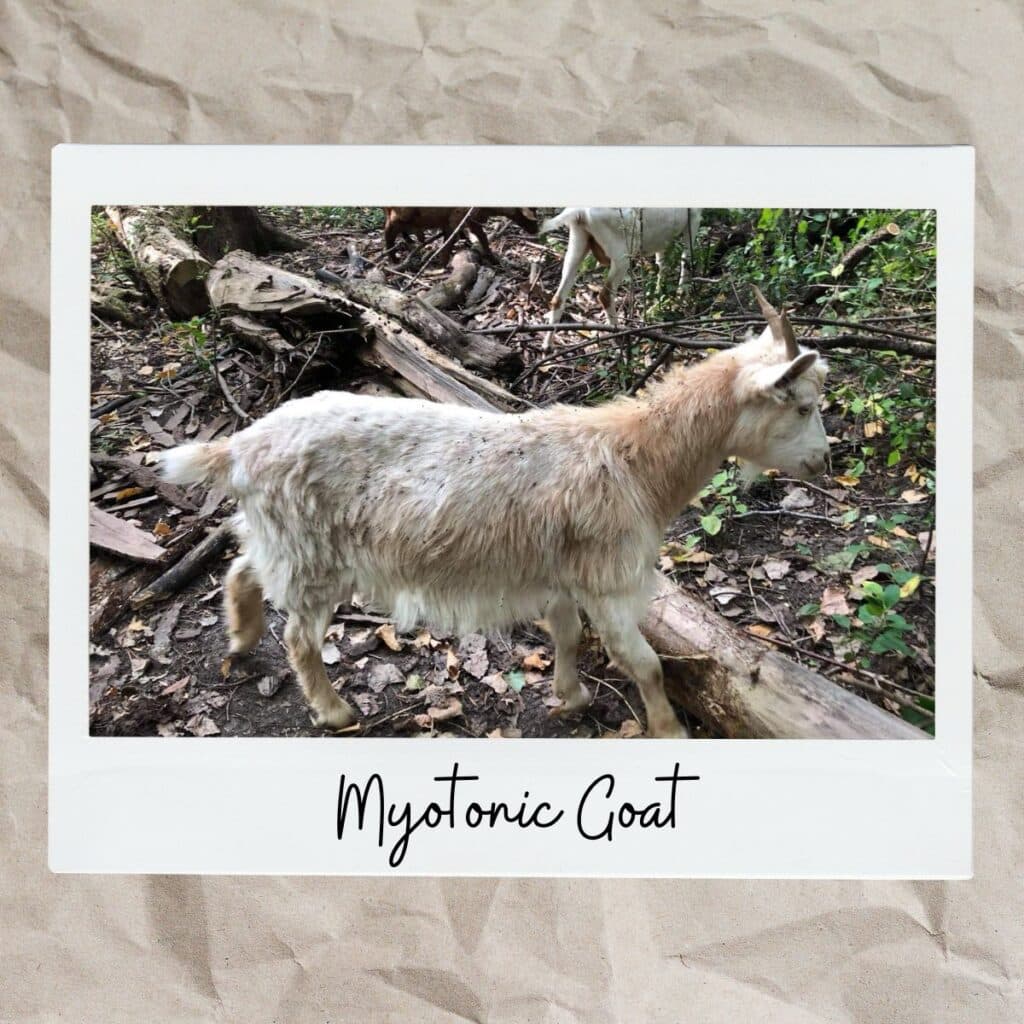
Kiko Goat
Originating from New Zealand, the Kiko goat is a meat goat breed growing rapidly in popularity in the U.S.
The name kiko is the Maori word for flesh – as in meat. Maori are the indigenous people of New Zealand.
The breed originated with feral goats that escaped over the last century with the European settlement in the country. The Kiko came to be in the late 1980s with cross breeding feral does with Angle Nubian, Toggenburg, and Saanen bucks. Kiko goats were later exported into the U.S. in the 1990s.
Kiko goat characteristics
The Kiko breed was developed to be a low input goat. They are easy keepers, require very little extra maintenance as they tend to be more parasite resistant, hearty, and have fewer hoof issues. Kikos tend to have strong maternal instincts, and good milk production for raising kids.
Kiko goats mature quickly on a low input management system, lean carcases.
The breed has medium sized ears that tend to stick out or forward. They are well known for their curving horns that go out to the side.
Kiko goat colors
Because the Kiko breed has been bred for its resiliency and growth rate, there are no common colors, coat type or pattern. Goats vary greatly in coloring in shades of white and brown and patterns.
Kiko goat disadvantages
Kiko goat disadvantages are few, but include less uniformity of thick, meaty body structure, as compared to Boer goats. However, many lines of Kiko genetics have impressive rate of gains making them a competitive, low cost meat goat breed to raise.
Being more active and energetic than other meat goat breeds can make them more of a challenge for first time goat owners since they can be harder to handle.
Learn more about Kiko goats
Learn more about the Kiko goat in my in-depth breed article here and with these organizations:
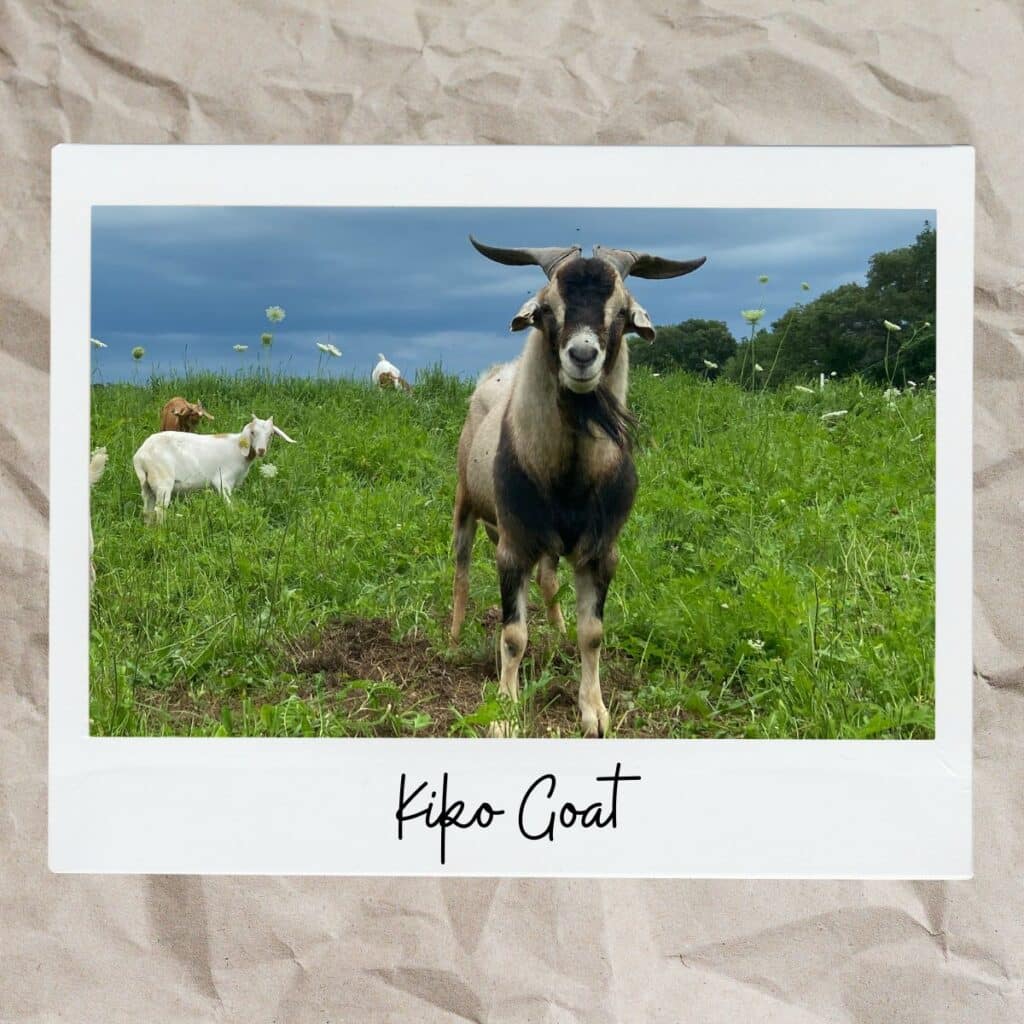
Meat goat crosses
Meat goat breed crosses have become extremely popular given the benefits of hybrid vigor. Cross breeding is combining the genetics of two (or more) breeds of goats to create offspring with the desired characteristics of both goat breeds.
Several popular meat goat breed crosses include:
Kiko boer goat cross
The Kiko Boer goat cross is a popular combination of desired traits for the body composition of the Boer goat and the heartiness, parasite resistance and ability to thrive on forage (low input) of the Kiko goat.
Boer Spanish goat cross
Boer Spanish goat cross is another popular mix of meat goat breeds. While both breeds have muscular body frames, the Spanish goat breed incorporates more parasite resistance characteristics, which the Boer breed tends to lack.
Breeds that are more parasite-resistant on pasture
The Kiko and Spanish breeds are more parasite-resistant than the Boer breed. A long-term research study at Tennessee State University showed the following percentage of does infected with parasites:
- Boer 53%
- Spanish 24%
- Kiko 22%
Little research has been done on Myotonic or Savana breeds.
The study was completed over a 12-year period and included raising the goats in a pasture-based environment (Browning, 2011).
Breeds that are more low maintenance / low input
Does, female goats, require less veterinary attention, assistance with kidding, and parasite challenges, and feed supplementation while producing more offspring are more profitable.
Research from Tennessee State University has shown that Kiko and Spanish meat goat breeds to be more productive over Boers. The research was done over 12 years with goats raised on low-to-moderate input systems.
| Characteristics | Boer | Kiko | Spanish |
|---|---|---|---|
| Percent of does kidding | 48.8% | 83.7% | 81.4% |
| Percent of does weaning kids | 30.5% | 71.5% | 71% |
| Litter size of weaned kids | 0.43 | 1.07 | 1.12 |
| Fecal egg counts | 1226 | 718 | 589 |
| Annual survival rate | 53.5% | 86.5% | 84.5% |
One last note about choosing a breed of goats
Note that where you purchase your goats and how you manage them on pasture with rotational grazing practices is just as important, if not more, as choosing a breed of meat goat.
These are two important factors I’ve learned through raising meat goats on our farm, Cylon Rolling Acres, in Western Wisconsin.
FAQs about meat goat breeds
There are about six common breeds of meat goats in the U.S. The Boer, Kiko, Myotonic, Savanna, Spanish and Texmaster.
There are over 80 breeds of goats. You can learn about the different breeds of goats on the Oklahoma State University Goat Breeds website.
The best choice for meat goats for cold climates is not specifically the breed of goat. Instead, farmers should be purchasing meat goat breeding stock from other farms in similar climates. This is true for cold climates as well.
Additionally, goats who have cashmere characteristics in their hair coat can be advantageous for goats raised in colder weather. This is because this additional fiber gives more insulation for the goats.
Learn more about how to transition goats to winter in this article.
Every meat goat farmer most likely can tell you their favorite breed for meat, which will likely vary. However, the most common and popular breed of meat goat is the Boer. This is due to it’s large, meaty build.
Yes, goat breeds can be mixed. In fact there is the potential for greater positive outcomes with goat kids who are from crossed breeds. This is called heterosis, which is the increase in performance of the offspring of the purebred (single breed) parents.
Research in livestock have show increased maternal ability, reproduction, lifespan, vitality of kids, rate of gain. Learn more about hetrosis in livetock in this article from South Dakota State University.
Yes, different breeds of goats can live together. However, goats of different genders and ages may need to be kept separate depending on the time of the year. For example, outside of breeding season, bucks are usually kept separate from the does.
Boer goats originated in South Africa in the mid-to-late 1600s. It is thought that they originated from a cross of indigenous African goats with European dairy breeds, likely Nubians.
Source: Story’s Guide to Raising Meat Goats.
Myotonic goats faint due to what’s called “myotonia congentia,” which is a a neuromuscular condition where the goats muscles will stay contracted for a longer period of time whenever a goat may be startled. They actually don’t faint, they remain awake while their body is stiff.
Source: Story’s Guide to Raising Meat Goats.
Yes, myotonic goats are the same as fainting goats. They are sometimes also called Texas Wooden Legs.
Nubian goats are dairy goats. However, they are the most dual-purpose breed of dairy goats due to their solid built, stocky frame. They are a good choice as a dairy goat breed that can be also used for meat.
Nigerian Dwarf goats are a breed designed for dairy production. Due to their shorter size and dairy frame, which carries less muscle they aren’t the best breed for the main purpose of meat production.
However, they can still be used for meat. Some dairy goat farmers will cross-breed their Nigerian Dwarf does with a meat breed buck to produce thicker, stockier kids with the goal of being raised for meat.
Alpine goats are dairy goat breed. Due to their dairy body frame, which carries less muscle they aren’t the best breed for solely meat production.
However, they can still be used for meat. Some dairy goat farmers will cross-breed their Alpine does with a meat breed buck to produce thicker, stockier kids with the goal of being raised for meat.e used for meat.
Angora goats are raised usually as a fiber goat. They can be crossbred with other traditional meat goat breeds to product kids with more meat-breed characteristics. Angoras also usually require they be sheared 1-2 times a year.
Lamancha goats are a breed designed for dairy production. With their dairy body frame they carry less muscle, making them not designed primarily for meat production.
However, they can still be used for meat. Some dairy goat farmers will cross-breed their Lamancha does with a meat breed buck to produce thicker, stockier kids with the goal of being raised for meat.
While pygmy goats were once bred to be a meat goat, they are not typically considered meat goat breed today.
References
- Browning, R., Leite-Browning, M.L., and Byares, Jr. M. (2011). Reproductive and health traits among Boer, Kiko, and Spanish meat goats under humid, subtropical pasture conditions of the southeastern United States. Journal of Animal Science.
- Browning, R., and Leite-Browning, M. (2020). Comparison of productivity of different breeds of meat goats under low-to-moderate-input systems in the United States. Professional Agricultural Workers Journal.
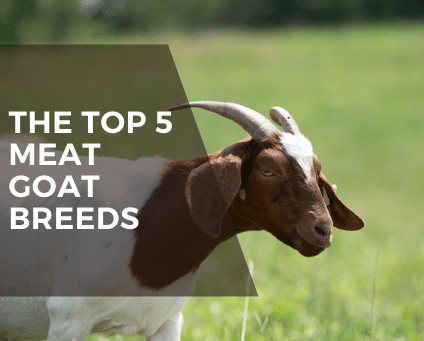
LEAVE A COMMENT
Comments